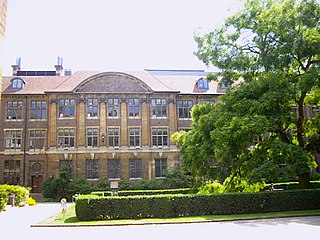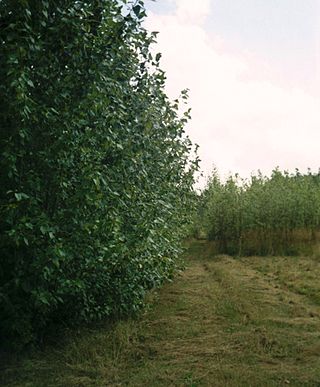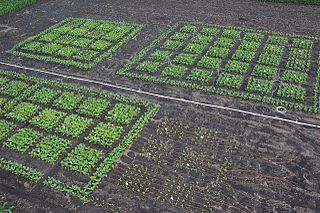
Photosynthesis is a biological process used by many cellular organisms to convert light energy into chemical energy, which is stored in organic compounds that can later be metabolized through cellular respiration to fuel the organism's activities. The term usually refers to oxygenic photosynthesis, where oxygen is produced as a byproduct and some of the chemical energy produced is stored in carbohydrate molecules such as sugars, starch, glycogen and cellulose, which are synthesized from endergonic reaction of carbon dioxide with water. Most plants, algae and cyanobacteria perform photosynthesis; such organisms are called photoautotrophs. Photosynthesis is largely responsible for producing and maintaining the oxygen content of the Earth's atmosphere, and supplies most of the biological energy necessary for complex life on Earth.

Wheat is a grass widely cultivated for its seed, a cereal grain that is a worldwide staple food. The many species of wheat together make up the genus Triticum ; the most widely grown is common wheat. The archaeological record suggests that wheat was first cultivated in the regions of the Fertile Crescent around 9600 BC. Botanically, the wheat kernel is a caryopsis, a type of fruit.

The Department of Plant Sciences is a department of the University of Cambridge that conducts research and teaching in plant sciences. It was established in 1904, although the university has had a professor of botany since 1724.

Genetically modified crops are plants used in agriculture, the DNA of which has been modified using genetic engineering methods. Plant genomes can be engineered by physical methods or by use of Agrobacterium for the delivery of sequences hosted in T-DNA binary vectors. In most cases, the aim is to introduce a new trait to the plant which does not occur naturally in the species. Examples in food crops include resistance to certain pests, diseases, environmental conditions, reduction of spoilage, resistance to chemical treatments, or improving the nutrient profile of the crop. Examples in non-food crops include production of pharmaceutical agents, biofuels, and other industrially useful goods, as well as for bioremediation.

Energy crops are low-cost and low-maintenance crops grown solely for renewable bioenergy production. The crops are processed into solid, liquid or gaseous fuels, such as pellets, bioethanol or biogas. The fuels are burned to generate electrical power or heat.
Martin Gibbs was an American biochemist and educator who worked in the field of carbon metabolism. The Martin Gibbs Medal, an award honoring individuals in plant sciences, is named in his honor.

John Lennox Monteith DSc, FRS was a British scientist who pioneered the application of physics to biology. He was an authority in the related fields of water management for agricultural production, soil physics, micrometeorology, transpiration, and the influence of the natural environment on field crops, horticultural crops, forestry, and animal production.

Short rotation coppice (SRC) is coppice grown as an energy crop. This woody solid biomass can be used in applications such as district heating, electric power generating stations, alone or in combination with other fuels. Currently, the leading countries in area planted for energy generation are Sweden and the UK.
Howard Griffiths is a physiological ecologist. He is Professor of Plant Ecology in the Department of Plant Sciences at the University of Cambridge, and a Fellow of Clare College, Cambridge. He formerly worked for the University of Dundee in the Department of Biological Sciences. He applies molecular biology techniques and physiology to investigate the regulation of photosynthesis and plant water-use efficiency.
Julian Michael Hibberd is a Professor of Photosynthesis at the University of Cambridge and a Fellow of Emmanuel College, Cambridge.
The Carl R. Woese Institute for Genomic Biology (IGB) is an interdisciplinary facility for genomics research at the University of Illinois Urbana-Champaign. The Institute was built in 2006 to centralize biotechnology research at the University of Illinois. Current research at the IGB explores the genomic bases of a wide range of phenomena, including the progression of cancer, the ecological impact of global change, tissue and organ growth, and the diversity of animal behavior.

Govindjee is an Indian-American scientist and educator. He is Professor Emeritus of Biochemistry, Biophysics and Plant Biology at the University of Illinois at Urbana-Champaign, where he taught from 1961 until 1999. As Professor Emeritus since 1999, Govindjee has continued to be active in the field of photosynthesis through teaching and publishing. He is recognized internationally as a leading expert on photosynthesis.
Harris A. Lewin, an American biologist, is a professor of evolution and ecology and Robert and Rosabel Osborne Endowed Chair at the University of California, Davis. He is a member of the National Academy of Sciences. In 2011, Lewin won the Wolf Prize in Agriculture for his research into cattle genomics. Lewin chairs the working group for the Earth BioGenome Project, a moonshot for biology that aims to sequence, catalog, and characterize the genomes of all of Earth’s eukaryotic biodiversity over a period of 10 years. Lewin is a founding co-editor of the Annual Review of Animal Biosciences, first published in 2013.

Realizing Increased Photosynthetic Efficiency (RIPE) is a translational research project that is genetically engineering plants to photosynthesize more efficiently to increase crop yields. RIPE aims to increase agricultural production worldwide, particularly to help reduce hunger and poverty in Sub-Saharan Africa and Southeast Asia by sustainably improving the yield of key food crops including soybeans, rice, cassava and cowpeas. The RIPE project began in 2012, funded by a five-year, $25-million dollar grant from the Bill and Melinda Gates Foundation. In 2017, the project received a $45 million-dollar reinvestment from the Gates Foundation, Foundation for Food and Agriculture Research, and the UK Government's Department for International Development. In 2018, the Gates Foundation contributed an additional $13 million to accelerate the project's progress.

The CO2 fertilization effect or carbon fertilization effect causes an increased rate of photosynthesis while limiting leaf transpiration in plants. Both processes result from increased levels of atmospheric carbon dioxide (CO2). The carbon fertilization effect varies depending on plant species, air and soil temperature, and availability of water and nutrients. Net primary productivity (NPP) might positively respond to the carbon fertilization effect. Although, evidence shows that enhanced rates of photosynthesis in plants due to CO2 fertilization do not directly enhance all plant growth, and thus carbon storage. The carbon fertilization effect has been reported to be the cause of 44% of gross primary productivity (GPP) increase since the 2000s. Earth System Models, Land System Models and Dynamic Global Vegetation Models are used to investigate and interpret vegetation trends related to increasing levels of atmospheric CO2. However, the ecosystem processes associated with the CO2 fertilization effect remain uncertain and therefore are challenging to model.

Anthony William Derek Larkum is a british plant scientist and academic based in Sydney. He is Professor Emeritus of Plant Sciences at the University of Sydney and Adjunct Professor at the University of Technology Sydney (UTS).

Reinhart Jan Maria Ceulemans is an emeritus professor of Ecology and previous director of the Research Center of Excellence PLECO of the University of Antwerp. He has been vice-dean of the Faculty of Sciences at the University of Antwerp, and was a visiting professor at the University of Washington, Seattle, USA (1987-1988), at the Université Paris-Sud XI, Orsay and at the University of Ghent. He officially retired in October 2019 and is now a visiting professor at the University of Antwerp (Belgium), a researcher at CzechGlobe Academy of Sciences in Brno and an international consultant to the Slovenian Forestry Institute.

Elizabeth Anna Ainsworth is an American plant physiologist currently employed by the United States Department of Agriculture (USDA) Agricultural Research Service (ARS). She also is an adjunct professor of the University of Illinois at Urbana-Champaign (UIUC), a Fellow of the American Association for the Advancement of Science (AAAS) and was awarded the 2018 Crop Science Society of America Presidential Award. She is known for her work concerning the effects of specific atmospheric pollutants, including ozone and carbon dioxide, on the productivity of selected major crops such as corn and soybeans.

Donald Richard Ort is an American botanist and biochemist. He is the Robert Emerson Professor of Plant Biology and Crop Sciences at the University of Illinois at Urbana-Champaign where he works on improving crop productivity and resilience to climate change by redesigning photosynthesis. He is a member of the National Academy of Sciences (NAS) and a fellow of the American Association for the Advancement of Science (AAAS) and American Society of Plant Biologists (ASPB).
Katrien M. Devos is an American plant geneticist who is distinguished research professor at the University of Georgia. Her research considers the structure, function and evolution of the genomes of grasses. In particular, Devos considers halophytic turfgrasses, cereals and bioenergy crops. She was elected Fellow of the American Association for the Advancement of Science in 2016.















